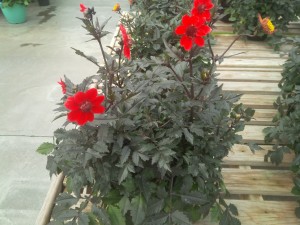 In the great book of gardening truths, one truth stands out: a gardener’s reach always exceeds his or her grasp. Passionate gardeners dream big, but they are always short of time, sunny days, available space and—inevitably—money. This is not necessarily a bad thing. Lack of cash or at least the necessity of sticking to a defined garden budget can be a springboard to creativity.
In the great book of gardening truths, one truth stands out: a gardener’s reach always exceeds his or her grasp. Passionate gardeners dream big, but they are always short of time, sunny days, available space and—inevitably—money. This is not necessarily a bad thing. Lack of cash or at least the necessity of sticking to a defined garden budget can be a springboard to creativity.
I am trying to combine my growing love of dahlias with a little of that budget-inspired creativity.
At the end of last season, I made a resolution to put more dahlias in my sunny border. They are such glorious end-of-summer flowers—dramatic in the garden and ideal for cutting. Every garden I noticed in August and September seemed to have bumper crops of dahlias, which made me crazy with envy. Treating the root cause of that envy, literally and figuratively, I started to think about my dahlia options.
Like most people, I generally grow dahlias from tubers, which is the quickest way to get blooms, short of buying young potted specimens. Individual dahlia tubers are not terribly expensive—most decent ones fall into the five-to-ten dollar range. But a significant dahlia investment can be costly.
Veteran dahlia growers in cold winter climates amortize the initial expense by digging and storing the tubers after the first frost in the fall. If I accumulate a sizeable dahlia collection, I will probably do that as well, but for now, I have to think about ways of getting the greatest number of dahlias at the lowest cost.
The answer came along with the first spring garden catalogs. One of my favorite vendors advertised packets of seeds for ‘Bishop’s Children Mix’, a collection of dahlias in many colors. All “Bishop’s Children’ dahlias were initially bred from a famous hybrid variety, ‘Bishop of Llandaff’. The original ‘Bishop’ features gorgeous red petals and foliage that is almost black. The combination is dramatic and showy.
I am fond of the ‘Bishop’, but I am absolutely besotted with the ‘Children’.
‘Bishop’s Children’ come in varying colors, with flowers that may be yellow, shades of orange or peach, red or bi-colored. All the ‘Children’ feature the same near-black stems that distinguish the parent.
I can buy one packet of ‘Bishop’s Children’ seeds, containing approximately 70 seeds, for three dollars, or I can buy individual ‘Bishop’s Children’ tubers for five dollars apiece. The choice is clear—I will grow dahlias from seed this year.
Of course, that means that I will not know what colors I have until the flower buds develop. Control over color and other specific traits only happens if you produce clones by taking offshoots from a particular tuber and growing them on into mature plants. The mysteries of pollination and genetics mean that the seeds collected from one of the ‘Children’ may or may not produce plants that are like the parent plant. This introduces an element of serendipity into the garden planning process, but I don’t mind. I will find places for all of the ‘Children’ that survive to adult planthood. If some of them are especially lovely, I’ll wait until they develop mature tubers, take offshoots and grow them on.
I always take catalog copy with a large grain of salt, but the seed vendor states that if I start the dahlias indoors in March, they will bloom in the garden by the end of summer. If I tend my flock of ‘Bishop’s Children’ carefully, they should be ready to go outside when temperatures warm up.
The seed order is in and the seed trays will be ready. By next August, I hope that the ‘Bishop’s Children’ will make me into the dahlia queen of my neighborhood.
